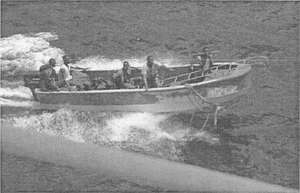- Author
- Periodical, Semaphore
- Subjects
- RAN operations, Post WWII
- Tags
-
- RAN Ships
- HMAS Ballarat II, HMAS Sydney IV
- Publication
- December 2009 edition of the Naval Historical Review (all rights reserved)
This article originally appeared in the August, 2009 edition of SEMAPHORE, published by the Seapower Centre of Australia.
On 29 May 2009 the Australian Government announced a decision to flexibly task the Australian Navy frigates deployed in the Middle East Area of Operations between anti-piracy operations and their existing counter-terrorism and maritime security patrols under Operation SLIPPER.
Formed primarily to combat piracy in the Gulf of Aden, Task Force 151 (currently commanded by Turkish Rear Admiral Caner Bener) is one of three task groups operating as part of the Coalition Maritime Forces (CMF), a multi-national organisation co-located with the United States (US) Navy’s Fifth Fleet Headquarters in Bahrain. The Commander CMF (Vice Admiral Bill Gortney, USN), is also the US Commander Fifth Fleet and has a Royal Navy commodore permanently posted as his Deputy CMF Commander. Nations contributing to the CMF include the United States, the United Kingdom, Australia, Canada, Denmark, Singapore, Bahrain, the United Arab Emirates, Turkey, Pakistan and Greece.
There has been a regular Royal Australian Navy (RAN) presence in the Arabian Gulf since the 1990-91 Gulf War, working primarily in and around Iraqi territorial waters. But with the expiration of United Nations Security Council Resolution 1790 on 31 December 2008, the Australian government re-deployed the ship away from Iraqi waters to operations elsewhere in the Arabian Gulf.
Like all navies, the RAN is bound under the United Nations Convention on the Law of the Sea 1982 to suppress piracy wherever it may occur. On 17 May 2009 two RAN frigates, HMA Ships Sydney and Ballarat were transiting through the Gulf of Aden on their way to the Red Sea. The ships were deployed as part of NORTHERN TRIDENT 09, a global deployment to conduct a range of exercises with many navies around the world, and supporting the diplomatic role that navies are so valuable in executing; they were not in the region specifically for anti-piracy operations.
Given the prevalence of piracy around Somalia and the Horn of Africa, however, they had established communications with CMF Headquarters in Bahrain and worked through some possible scenarios should piracy be encountered. The RAN’s longstanding commitment to the Gulf region, coupled with regular exercises with the US Navy and other key allies, meant that it was relatively easy for Sydney and Ballarat to be force assigned to Chief of Joint Operations (Australia) to act in support of the Combined Force Maritime Component Command counter piracy efforts while transiting the area.
One of the most successful ways to combat piracy is through presence, leading to deterrence. Pirates are generally motivated by money and will pick easy targets, so the presence of a warship is often enough for them to abort any attempted attack and seek easier prey. To capitalise on this, an ‘internationally recognised transit corridor‘ has been established through the Gulf of Aden. Warships regularly patrol along this ‘corridor’ which is used by most merchant ships so that, if required, help is relatively close at hand. It was through this corridor that Sydney and Ballarat travelled.

At 1116 local time on 17 May 2009 Sydney and Ballarat heard a radio call for help on the international distress frequency from the oil tanker MV Dubai Princess, under Captain Syed MA Naqvi, stating that she was under attack by pirates and requesting assistance. Sydney established communications and quickly determined that Dubai Princess was 20 nautical miles (nm) ahead, travelling in the same direction. Both warships increased to maximum speed and Sydney prepared to launch her Seahawk helicopter. Sydney recommended that Dubai Princess reverse her course to reduce the time to close, but the ship’s Master was initially reluctant, as the pirate skiffs were astern of him.
At 1140 Dubai Princess reported that she was being fired upon by small arms and rocket propelled grenades, so Sydney and Ballarat went to Action Stations and Sydney’s helicopter was launched as soon as it was ready. Although the pirates made numerous boarding attempts they were unsuccessful due to the self-protection measures adopted by the tanker’s crew. Captain Naqvi then attempted to reverse course, but he was at full power and the heavy manoeuvring was straining his engines. Sydney‘s bridge staff could hear engineering alarms sounding in the background when Dubai Princess transmitted on radio.




